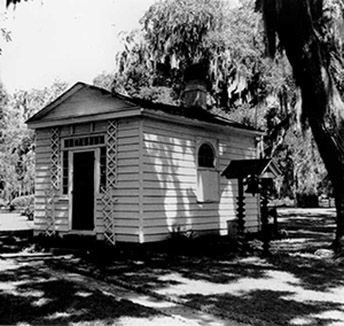Last updated: March 5, 2020
Lesson Plan
Discover American Life & Labor at Chicora Wood: A Lightning Lesson from Teaching with Historic Places

- Grade Level:
- High School: Ninth Grade through Twelfth Grade
- Subject:
- Literacy and Language Arts,Social Studies
- Lesson Duration:
- 60 Minutes
- Common Core Standards:
- 6-8.RH.10, 9-10.RH.1, 9-10.RH.2, 9-10.RH.3, 9-10.RH.4, 9-10.RH.5, 9-10.RH.6, 9-10.RH.7, 9-10.RH.8, 9-10.RH.9, 11-12.RH.1, 11-12.RH.2, 11-12.RH.3, 11-12.RH.4, 11-12.RH.5, 11-12.RH.6, 11-12.RH.7
- Additional Standards:
- See full lesson plan document for National History Standards and NCSS Standards & Themes
- Thinking Skills:
- Remembering: Recalling or recognizing information ideas, and principles. Understanding: Understand the main idea of material heard, viewed, or read. Interpret or summarize the ideas in own words. Applying: Apply an abstract idea in a concrete situation to solve a problem or relate it to a prior experience. Analyzing: Break down a concept or idea into parts and show the relationships among the parts. Creating: Bring together parts (elements, compounds) of knowledge to form a whole and build relationships for NEW situations. Evaluating: Make informed judgements about the value of ideas or materials. Use standards and criteria to support opinions and views.
Essential Question
Whose labor built America? What historic place might you study to answer this question?
Objective
1. To explain the connection between forced labor of African Americans and prosperity for European Americans;
2. To list the ways the Allston family made rice production at Chicora Wood Plantation exceptionally profitable;
3. To identify exploitative systems of labor in present day nations and present research on one or more of those systems.
Background
Time Period: 1750s - 1860s
Topics: This lesson could be used in units on labor history, agriculture, geography, and Antebellum slavery in the American South
Preparation
Spanning 250 years, from the English settlement of the Virginia Colony until the American Civil War, the ruling classes of North America’s eastern territories used different forms of legal slavery to produce cash crops on large pieces of land. In the 17th century, enslaved Africans and European indentured servants worked side-by-side. In the 18th century, American slavery evolved into racialized caste system. Enslaved Africans and their descendants were legally a class of enslaved labor by the Revolution. This system supported plantations that produced valuable cotton, rice, indigo, and sugar. These goods traveled the globe, making a portion of the world’s population very wealthy at the expense of human suffering and exploitation.
In Georgetown County, South Carolina, plantation owners used fertile land and labor to produce rice. The rice plantation owners bought Africans who were skilled in rice production. Through the Africans’ agricultural knowledge and their exploitation, South Carolina became the nation's leading rice producer between the 1750s and the late 1860s. This economic success was largely earned through the work of the large enslaved population.
Chicora Wood was a rice plantation where hundreds of enslaved people lived and worked, from the 1730s until the Civil War. Enslaved Africans and their descendants cleared woods, cultivated and harvested rice, and constructed homes for their enslavers, the Allston family. By the mid-1800s, their labor made Chicora Wood one of the most profitable businesses in South Carolina and made the Allstons very wealthy.
Procedure
Getting Started Prompt
Map: Orients the students and encourages them to think about how place affects culture and society
Readings: Primary and secondary source readings provide content and spark critical analysis.
Visual Evidence: Students critique and analyze visual evidence to tackle questions and support their own theories about the subject.
Optional post-lesson activities: If time allows, these will deepen your students' engagement with the topics and themes introduced in the lesson, and to help them develop essential skills.
Vocabulary
Thrashing
Additional Resources
Narratives of Enslavement
The Library of Congress: Voices from the Days of Slavery
The American Folklife Center houses almost seven hours of recorded interviews of formerly enslaved individuals taken between 1932 and 1975. See the faces of seven individuals as they describe being a slave and becoming free.
National Endowment for the Humanities: EDSITEment!
The NEH offers an education guide containing vetted resources for teaching African American history, including life under slavery, free black people, and resistance to slavery.
Sites of Slavery
The Whitney Plantation
The Whitney Plantation interprets their site solely through the lens of slavery and enslavement. Their site contains videos, lesson plans, primary sources, and photos about the transatlantic slave trade, plantation landscapes and daily life, artwork, and first-person slave narratives.
James Madison’s Montpelier: “The Mere Distinction of Colour”
Over 300 enslaved individuals lived at Montpelier. The Montpelier website shares oral histories from the active descendent community, archaeological discoveries, and an award-winning exhibit titled “The Mere Distinction of Colour” to tell the complex story of freedom and enslavement while working for the framer of the Constitution.
Modern Day Slavery
Students Opposing Slavery – President Lincoln’s Cottage
The National Trust for Historic Preservation site, President Lincoln’s Cottage, supports Students Opposing Slavery. SOS is an educational program aimed to raise awareness of human trafficking and empower young leaders to end modern day slavery.
Current & Historic Tribal Communities
As of 2018 there are eight state-recognized tribes in South Carolina: Catawba Indian Nation, Beaver Creek Indians, Edisto Natchez Kusso Tribe, Pee Dee Indian Nation, the Piedmont American Indian Association, Santee Indians, Sumter Tribe, and the Waccamaw. Many live in or near Georgetown County. Other native communities, such as Chicora, exist separate to this designation.
Pee Dee Indian Tribe
The Pee Dee Indian Tribe focuses on advocating, educating, and empowering the next generation of Pee Dee and other American Indian groups. One website contains information about the Pee Dee tribal government as well as their Tribal history.
Waccamaw Indian People
The Waccamaw website contains current events, an essay collection about the Waccamaw Indians, and interviews with Chief Hatcher.
Catawba Tribe
The Catawba Cultural Preservation website provides information about Tribal history, events and programs, and information about the cultural center.
